The ASUS Z370-I Gaming Review: Mini-Me Mega Motherboard
by Joe Shields on May 21, 2018 11:00 AM EST- Posted in
- Motherboards
- Intel
- Mini ITX
- Asus
- Coffee Lake
- Z370
- Z370-I Gaming
Visual Inspection
The ASUS Z370-I Gaming motherboard, like other Mini-ITX boards, doesn't leave a lot of room for design aesthetics. There is really only room for the components we can see on the board, without having to add more real estate vertically like the ASRock X299-E ITX/ac or ROG Impact boards did with extra daughterboards. The ASUS board uses two separate aluminum heatsinks to cool the power delivery area as well as the chipset and front M.2 slot. Outside of that, there is some grey stenciling in what little free area there is on the front. While the two DRAM slots are not reinforced, the single PCIe slot is.
A total of 13 RGB LEDs line the back of the board of the board under the 24-pin ATX plug and SATA ports. This is designed to give the board a warm glow when it is powered on. An additional RGB header is located on the right side of the board next to the 24-pin ATX plug - all can be controlled through the ASUS Aura Lighting software.
The Z370-I comes with a total of three 4-pin fan headers, one of which is designed for AIO Pumps. The CPU fan header is located near the 8-pin EPS 12V connector towards the top left. The AIO pump (no mention of power capabilities) sits in the middle and the chassis fan sits just above the PCIe slot on the bottom. Both CPU headers are hybrid and support 3-pin (DC) or 4-pin (PWM) fans and are able to output 1A/12W.
ASUS uses its Digi+ chip (ASPB1400BT) in a 6 + 2 configuration using the OnSemiconductor 4C09B-RG050 MOSFETs. Sending power to the CPU is a single 8-pin EPS connector.
The right side of the board is where a lof the action happens. From left to right we are able to see a front panel USB 3.0 header, the two DRAM slots, four SATA ports (2 on each side of the DRAM slots), a USB 2.0 header, RGB LED header, and the 24-pin ATX connector.
This picture above shows a close up of SATA ports 1/2 while 3/4 are seen in the background by the single clip DRAM slots.
One of the interesting elements to this mothebroard is the audio section. ASUS likes to spend time on the audio, and here they have managed to do most of what is possible on a full-size ATX board: PCB separation between analog and digital signals, an EMI shield over the codec (Realtek ALC1220A), and additional audio filter caps. Most other motherboards in this segment opt for a simple solution, or with the more built-up Mini-ITX boards we have seen daughter boards offer extra space for audio performance. The key here from ASUS is to make sure that the EMI shield does not interfere with large graphics cards.
The back panel IO (seen below) is fairly busy containing the USB ports, audio outputs, network connections, and video outputs
- 2 x USB 3.0 ports
- 4 x USB 2.0 ports
- Displayport and HDMI Video Outputs
- Intel I219-V NIC
- 2 x USB 3.0 ports
- Intel Wi-Fi stack
- Audio stack
In the Box
ASUS includes the following:
- User Manual
- M.2 2242 Mounting Kit
- I/O Shields
- 4 x SATA cables
- 2 x M.2 screw packages
- 1 x CPU installation tool
- 1 x ROG addressable LED strip (not pictured)
- 1 x ASUS 2T2R Wi-Fi Moving antennas
- 1 x SCD
- 1 x Panel cable
- 1 x Strix Series stickers




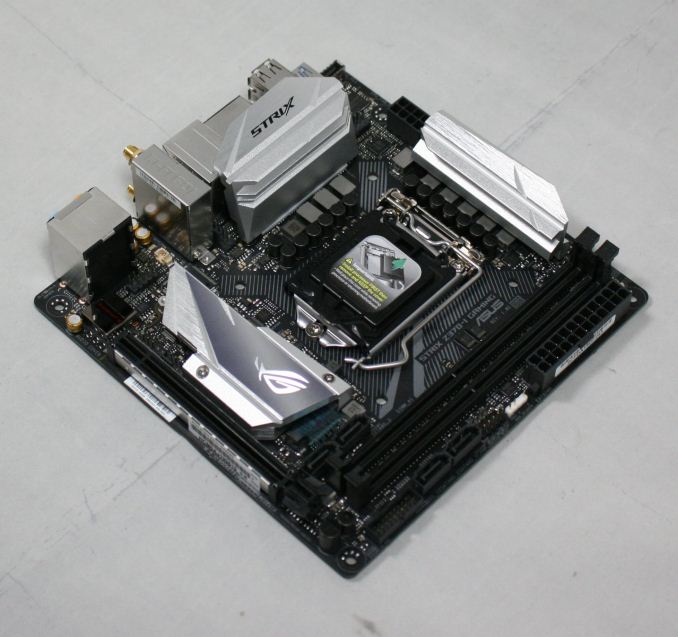
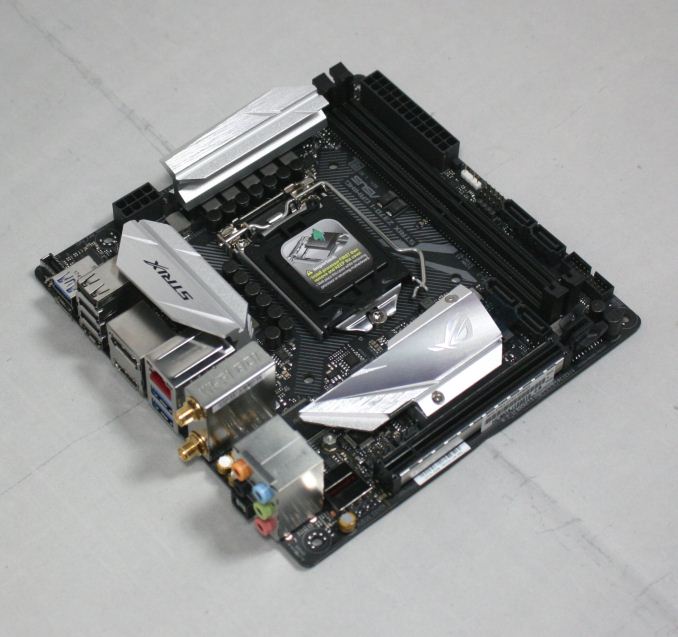
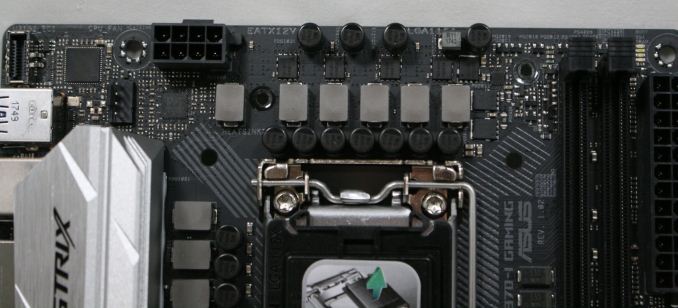
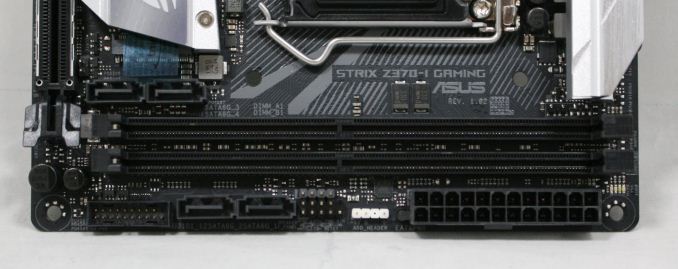
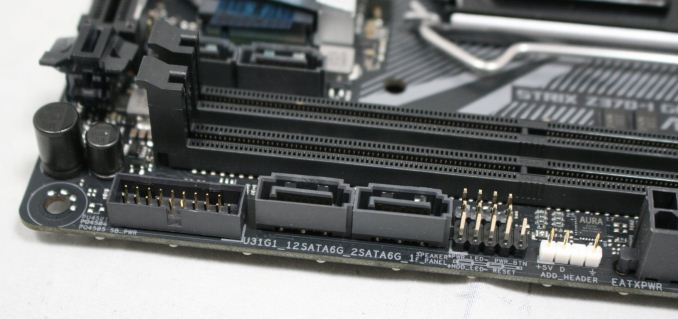
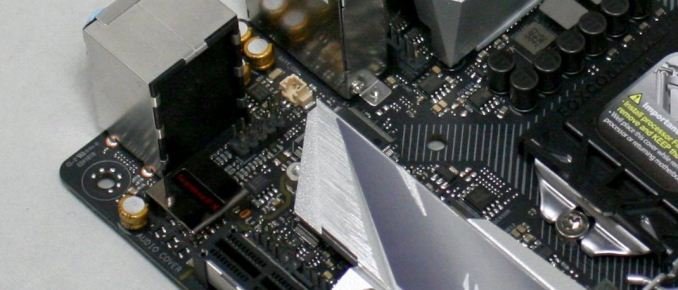
















37 Comments
View All Comments
Ian Cutress - Monday, May 21, 2018 - link
Correct; updated.hansmuff - Monday, May 21, 2018 - link
A DisplayPort connector! Yay! Too many Mini-ITX have been skipping those, including some ASUS boards.ಬುಲ್ವಿಂಕಲ್ ಜೆ ಮೂಸ್ - Monday, May 21, 2018 - link
"it is worth nothing that the Type-C connector isn't USB 3.1 (10 Gbps)"
-------------------------
It must be worth something or why even have it?
LOL
Mr Perfect - Monday, May 21, 2018 - link
What are the BIOS defaults like?We've got a couple older Z170 Asus Maximus VIII Impact machines around, and for some reason the BIOS defaults to all non-standard values. If you want to run things at stock/standard you have to specifically change them to be that. It's especially annoying because BIOS updates reset all of your settings to Asus' defaults.
Asus has some nice hardware, but I really don't feel like fighting them on BIOS defaults.
nimi - Tuesday, May 22, 2018 - link
What do you mean by non-standard values? Did you accidentally load a overclocking profile or something?12345 - Tuesday, May 29, 2018 - link
It's very common for intel motherboards to set very high voltages for stuff like system agent. This very board will auto set vccio and vccsa to like 1.2-1.3v when the bios itself describes default as like .96vnimi - Tuesday, May 22, 2018 - link
You forgot to edit the copy/pasted lineup table on the first page, it claims this review is for the Maximus X Apex with the Z370-I Gaming "in testing".AnnoyedGrunt - Tuesday, May 22, 2018 - link
I've been very intrigued by the mini-ITX format for a new build. I'd be doing an AMD version, but from what I can see, if you aren't going to do SLI, the mini-ITX boards offer a great value. You get intel networking, intel wi-fi, Realtek 1220 sound, NVME storage slots, all in a small package with a reasonable cost.ATX boards with those features tend to be quite a bit more expensive, especially on the AMD side (or you sacrifice some of the features).
Of course, once you load up a build with an ATX PSU, large cooler, GPU, ODD (I still buy CD's and need a way to rip them) the size starts to be similar to a regular ATX build. Still, I like the minimalist approach to the motherboard.
-AG
imaheadcase - Tuesday, May 22, 2018 - link
You pointed out exact reason why not to get this, so this board should be used in most builds no problem. Its really nice simply to have a small case as well.creed3020 - Tuesday, May 22, 2018 - link
Error in the table at the bottom of page 1. The note [this review] is in the wrong row. Looks like a C&P error from the previous review of the ROG mITX board.